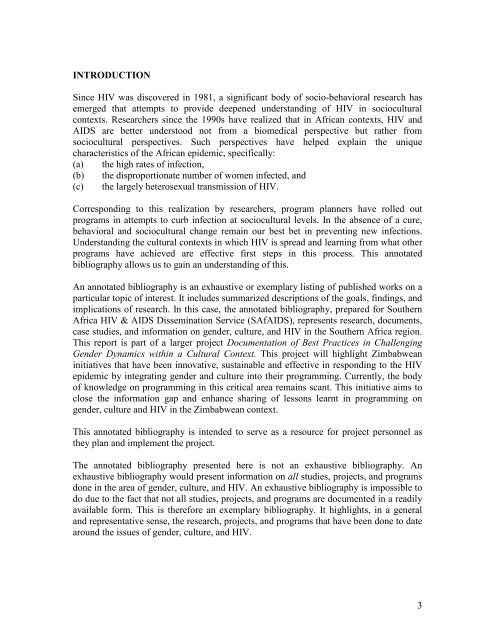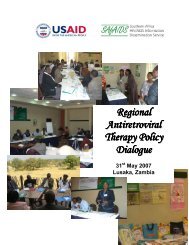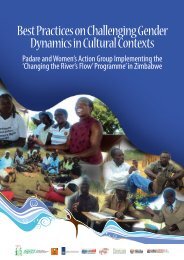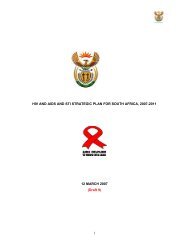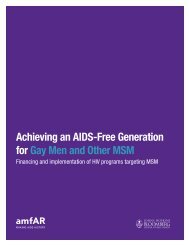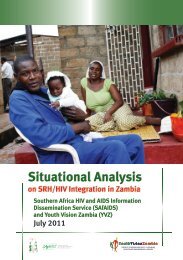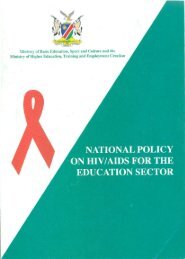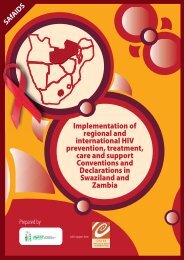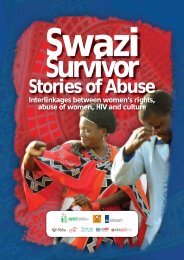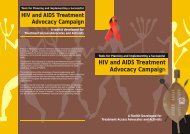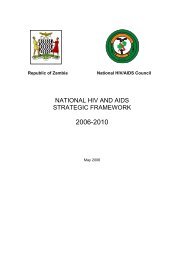Annotated Bibliography-Challenging Gender Dynamics ... - SAfAIDS
Annotated Bibliography-Challenging Gender Dynamics ... - SAfAIDS
Annotated Bibliography-Challenging Gender Dynamics ... - SAfAIDS
Create successful ePaper yourself
Turn your PDF publications into a flip-book with our unique Google optimized e-Paper software.
INTRODUCTIONSince HIV was discovered in 1981, a significant body of socio-behavioral research hasemerged that attempts to provide deepened understanding of HIV in socioculturalcontexts. Researchers since the 1990s have realized that in African contexts, HIV andAIDS are better understood not from a biomedical perspective but rather fromsociocultural perspectives. Such perspectives have helped explain the uniquecharacteristics of the African epidemic, specifically:(a) the high rates of infection,(b) the disproportionate number of women infected, and(c) the largely heterosexual transmission of HIV.Corresponding to this realization by researchers, program planners have rolled outprograms in attempts to curb infection at sociocultural levels. In the absence of a cure,behavioral and sociocultural change remain our best bet in preventing new infections.Understanding the cultural contexts in which HIV is spread and learning from what otherprograms have achieved are effective first steps in this process. This annotatedbibliography allows us to gain an understanding of this.An annotated bibliography is an exhaustive or exemplary listing of published works on aparticular topic of interest. It includes summarized descriptions of the goals, findings, andimplications of research. In this case, the annotated bibliography, prepared for SouthernAfrica HIV & AIDS Dissemination Service (<strong>SAfAIDS</strong>), represents research, documents,case studies, and information on gender, culture, and HIV in the Southern Africa region.This report is part of a larger project Documentation of Best Practices in <strong>Challenging</strong><strong>Gender</strong> <strong>Dynamics</strong> within a Cultural Context. This project will highlight Zimbabweaninitiatives that have been innovative, sustainable and effective in responding to the HIVepidemic by integrating gender and culture into their programming. Currently, the bodyof knowledge on programming in this critical area remains scant. This initiative aims toclose the information gap and enhance sharing of lessons learnt in programming ongender, culture and HIV in the Zimbabwean context.This annotated bibliography is intended to serve as a resource for project personnel asthey plan and implement the project.The annotated bibliography presented here is not an exhaustive bibliography. Anexhaustive bibliography would present information on all studies, projects, and programsdone in the area of gender, culture, and HIV. An exhaustive bibliography is impossible todo due to the fact that not all studies, projects, and programs are documented in a readilyavailable form. This is therefore an exemplary bibliography. It highlights, in a generaland representative sense, the research, projects, and programs that have been done to datearound the issues of gender, culture, and HIV.3


